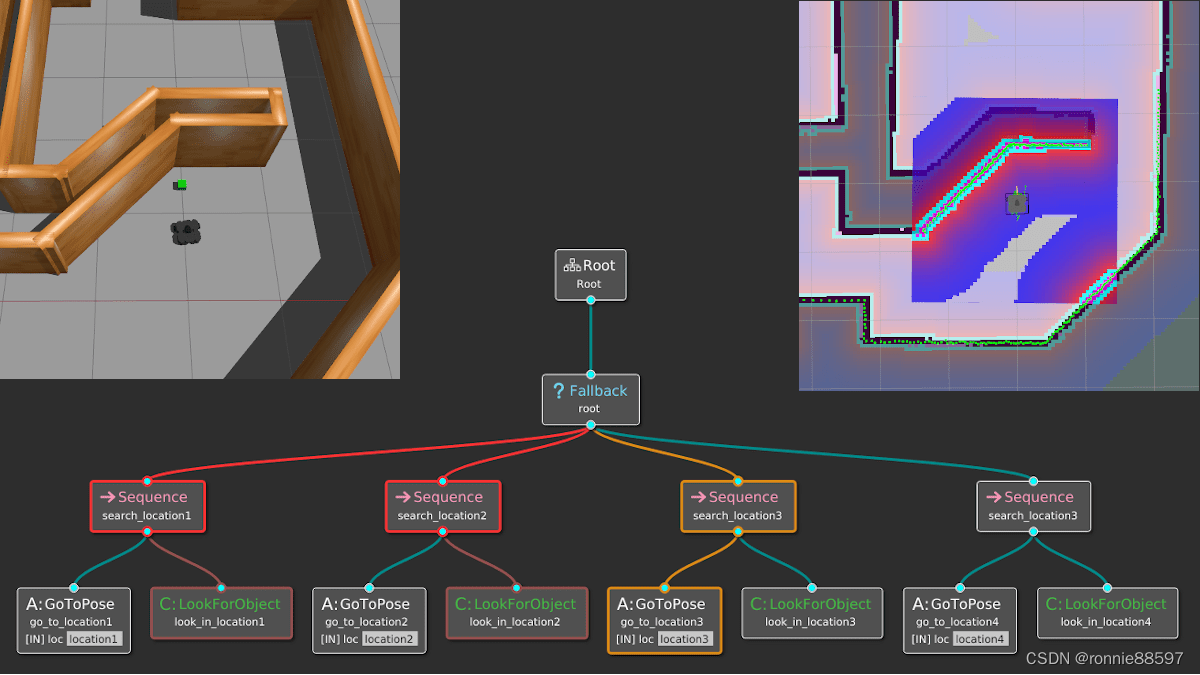 Abstraction in programming has evolved our use of computers from basic arithmetic operations to representing complex real-world phenomena using models. More specific to robotics, abstraction has moved us from low-level actuator control and basic sensing to reasoning about higher-level concepts behaviors, as I define in my Anatomy of a Robotic System post.
Abstraction in programming has evolved our use of computers from basic arithmetic operations to representing complex real-world phenomena using models. More specific to robotics, abstraction has moved us from low-level actuator control and basic sensing to reasoning about higher-level concepts behaviors, as I define in my Anatomy of a Robotic System post.
编程中的抽象化使我们对计算机的使用从基本的算术运算发展到使用模型来表示复杂的现实世界现象。具体到机器人领域,抽象化使我们从低级别的执行器控制和基本传感转移到对高级别的概念行为进行推理,正如我在《机器人系统的解剖》一文中所定义的。
In autonomous systems, we have seen an entire host of abstractions beyond “plain” programming for behavior modeling and execution. Some common ones you may find in the literature include teleo-reactive programs, Petri nets, finite-state machines (FSMs), and behavior trees (BTs). In my experience, FSMs and BTs are the two abstractions you see most often today.
在自主系统中,我们已经看到了一大批超越 "普通 "编程的行为建模和执行的抽象方法。你可能会在文献中发现一些常见的抽象,包括远程反应程序、Petri网、有限状态机(FSMs)和行为树(BTs)。根据我的经验,FSM和BT是你今天最常看到的两个抽象概念。
In this post, I will introduce behavior trees with all their terminology, contrast them with finite-state machines, share some examples and software libraries, and as always leave you with some resources if you want to learn more.
在这篇文章中,我将介绍行为树及其所有术语,将其与有限状态机进行对比,分享一些例子和软件库,并一如既往地给你留下一些资源,如果你想了解更多。
一、什么是行为树?
As we introduced above, there are several abstractions to help design complex behaviors for an autonomous agent. Generally, these consist of a finite set of entities that map to particular behaviors or operating modes within our system, e.g., “move forward”, “close gripper”, “blink the warning lights”, “go to the charging station”. Each model class has some set of rules that describe when an agent should execute each of these behaviors, and more importantly how the agent should switch between them.
正如我们上面所介绍的,有几个抽象概念可以帮助设计自主代理的复杂行为。一般来说,这些由一组有限的实体组成,这些实体映射到我们系统中的特定行为或操作模式,例如,“向前移动”、“关闭抓手”、“闪烁警告灯”、“去充电站”。每个模型类都有一些规则,描述了代理应该在什么时候执行这些行为,更重要的是代理应该如何在这些行为之间切换。
Behavior trees (BTs) are one such abstraction, which I will define by the following characteristics:
行为树(BT)就是这样一个抽象,我将通过以下特征来定义它:
-
Behavior Trees are trees (duh): They start at a root node and are designed to be traversed in a specific order until a terminal state is reached (success or failure).
行为树是树(duh): 它们从根节点开始,并被设计为按特定顺序遍历,直到达到一个终端状态(成功或失败)。
-
Leaf nodes are executable behaviors: Each leaf will do something, whether it’s a simple check or a complex action, and will output a status (success, failure, or running). In other words, leaf nodes are where you connect a BT to the lower-level code for your specific application.
叶子结点是可执行的行为: 每个叶子都会做一些事情,无论是简单的检查还是复杂的行动,并会输出一个状态(成功、失败或运行)。换句话说,叶子节点是你连接BT和你的具体应用的低级代码的地方。
-
Internal nodes control tree traversal: The internal (non-leaf) nodes of the tree will accept the resulting status of their children and apply their own rules to dictate which node should be expanded next.
内部节点控制树的遍历: 树的内部(非叶子)节点将接受其子节点的结果状态,并应用自己的规则来决定下一步应该展开哪个节点。
Behavior trees actually began in the videogame industry to define behaviors for non-player characters (NPCs): Both Unreal Engine and Unity (two major forces in this space) have dedicated tools for authoring BTs. This is no surprise; a big advantage of BTs is that they are easy to compose and modify, even at runtime. However, this sacrifices the ease of designing reactive behaviors (for example, mode switches) compared to some of the other abstractions, as you will see later in this post.
行为树实际上开始于电子游戏行业,用于定义非玩家角色(NPC)的行为: Unreal Engine和Unity(这个领域的两个主要力量)都有专门的工具来编写BTs。这并不奇怪;BT的一大优势是它们很容易构成和修改,甚至是在运行时。然而,与其他一些抽象概念相比,这牺牲了设计反应式行为(例如,模式切换)的便利性,你将在本篇文章的后面看到。
Since then, BTs have also made it into the robotics domain as robots have become increasingly capable of doing more than simple repetitive tasks. Easily the best resource here is the textbook “Behavior Trees in Robotics and AI: An Introduction” by Michele Colledanchise and Petter Ögren. In fact, if you really want to learn the material you should stop reading this post and go directly to the book … but please stick around?
从那时起,BT也进入了机器人领域,因为机器人越来越有能力做更多简单的重复性任务。这里最好的资源是Michele Colledanchise和Petter Ögren的教科书《机器人和人工智能中的行为树:简介》。事实上,如果你真的想学习这些材料,你应该停止阅读这篇文章,直接去看这本书…但请坚持一下?
下图是Unreal Engine中构建的行为树:
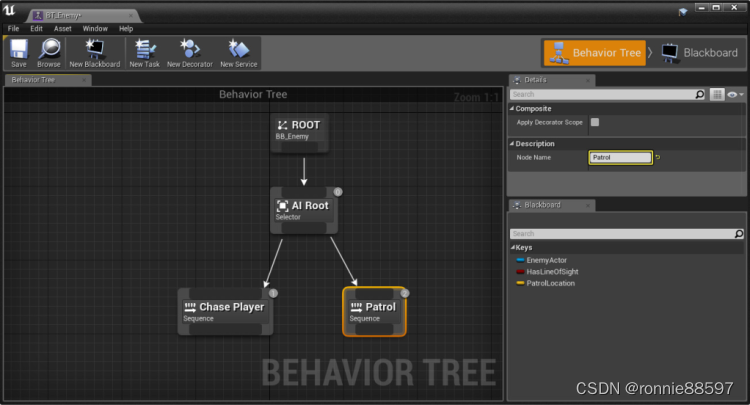 # 二、行为树术语
# 二、行为树术语
Let’s dig into the terminology in behavior trees. While the language is not standard across the literature and various software libraries, I will largely follow the definitions in Behavior Trees in Robotics and AI.
让我们来挖掘一下行为树中的术语。虽然这种语言在文献和各种软件库中并不标准,但我将主要遵循《机器人和人工智能中的行为树》中的定义。
At a glance, these are the types of nodes that make up behavior trees and how they are represented graphically:
一目了然,这些是构成行为树的节点类型,以及它们在图形上的表示方法:
行为树节点概览,如下图:
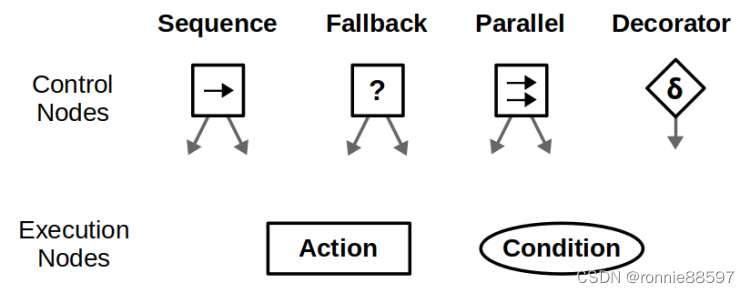
Behavior trees execute in discrete update steps known as ticks. When a BT is ticked, usually at some specified rate, its child nodes recursively tick based on how the tree is constructed. After a node ticks, it returns a status to its parent, which can be *Success*, *Failure*, or *Running*.
行为树以离散的更新步骤执行,称为tick。当一个BT被勾选时,通常以某种指定的速度,它的子节点会根据树的构建方式递归勾选。在一个节点被勾选后,它向它的父节点返回一个状态,这个状态可以是成功、失败或运行。
Execution nodes, which are leaves of the BT, can either be Action or Condition nodes. The only difference is that condition nodes can only return Success or Failure within a single tick, whereas action nodes can span multiple ticks and can return Running until they reach a terminal state. Generally, condition nodes represent simple checks (e.g., “is the gripper open?”) while action nodes represent complex actions (e.g., “open the door”).
执行节点是BT的叶子,可以是行动节点,也可以是条件节点。唯一的区别是,条件节点只能在一个tick内返回成功或失败,而行动节点可以跨越多个tick,并可以返回运行状态,直到它们达到一个终端状态。一般来说,条件节点代表简单的检查(例如,“抓手是否打开?”),而动作节点代表复杂的动作(例如,“开门”)。
Control nodes are internal nodes and define how to traverse the BT given the status of their children. Importantly, children of control nodes can be execution nodes or control nodes themselves. Sequence, Fallback, and Parallel nodes can have any number of children, but differ in how they process said children. Decorator nodes necessarily have one child, and modify its behavior with some custom defined policy.
控制节点是内部节点,定义了如何根据其子节点的状态遍历BT。重要的是,控制节点的子节点可以是执行节点或控制节点本身。顺序节点、回退节点和平行节点可以有任何数量的子节点,但在它们如何处理所述子节点方面有所不同。装饰器节点必须有一个子节点,并通过一些自定义的策略来修改其行为。
Scroll through the images below to see how the different control nodes work.
下面的图片,看看不同的控制节点如何工作。
-
Sequence nodes execute children in order until one child returns Failure or all children returns Success.
序列节点按顺序执行子节点,直到一个子节点返回失败或所有子节点返回成功。
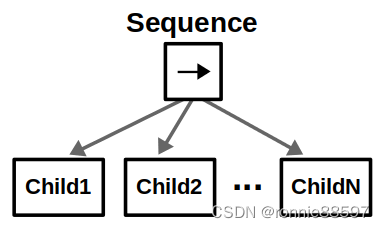
-
Fallback nodes execute children in order until one of them returns Success or all children return Failure. These nodes are key in designing recovery behaviors for your autonomous agents.
后退节点按顺序执行子节点,直到其中一个子节点返回成功或所有子节点返回失败。这些节点是为你的自主代理设计恢复行为的关键。
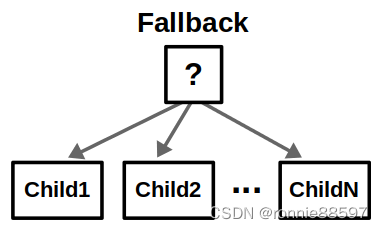
-
Parallel nodes will execute all their children in “parallel”. This is in quotes because it’s not true parallelism; at each tick, each child node will individually tick in order. Parallel nodes return Success when at least M child nodes (between 1 and N) have succeeded, and Failure when all child nodes have failed.
平行节点将 "平行 "地执行它们的所有子节点。这是有引号的,因为这不是真正的并行;在每次勾选时,每个子节点将按顺序单独勾选。当至少有M个子节点(介于1和N之间)成功时,平行节点会返回成功,而当所有子节点都失败时,则返回失败。

-
Decorator nodes modify a single child node with a custom policy. A decorator has its own set of rules for changing the status of the “decorated node”. For example, an “Invert” decorator will change Success to Failure, and vice-versa. While decorators can add flexibility to your behavior tree arsenal, you should stick to standard control nodes and common decorators as much as possible so others can easily understand your design.
装饰器节点用自定义的策略修改一个单一的子节点。一个装饰器有自己的一套规则来改变 "被装饰节点 "的状态。例如,一个 "反转 "装饰器将把成功改为失败,反之亦然。虽然装饰器可以为你的行为树武器库增加灵活性,但你应该尽可能地坚持使用标准的控制节点和常见的装饰器,这样别人就可以很容易地理解你的设计。
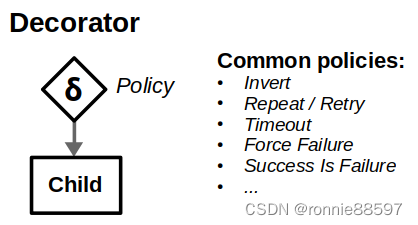
三、机器人实例: 搜索物体
The best way to understand all the terms and graphics in the previous section is through an example. Suppose we have a mobile robot that must search for specific objects in a home environment. Assume the robot knows all the search locations beforehand; in other words, it already has a world model to operate in.
理解上一节中所有术语和图形的最好方法是通过一个例子。假设我们有一个移动机器人,必须在家庭环境中搜索特定的物体。假设机器人事先知道所有的搜索地点;换句话说,它已经有了一个可以操作的世界模型。
Our mobile robot example. A simulated TurtleBot3 must move in a known map to find blocks of a given color.
我们的移动机器人例子。一个模拟的TurtleBot3必须在一个已知的地图中移动,以寻找给定颜色的块。
Let’s start simple. If there is only one location (we’ll call it A), then the BT is a simple sequence of the necessary actions: Go to the location and then look for the object.
让我们从简单的开始。如果只有一个地点(我们称之为A),那么BT就是一个简单的必要行动序列: 前往该地点,然后寻找该物体。
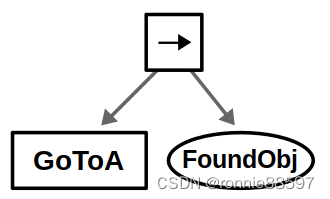
Our first behavior tree. Bask in the simplicity while you can…
我们的第一个行为树。趁你还可以的时候,享受一下这种简单的感觉吧…
We’ve chosen to represent navigation as an action node, as it may take some time for the robot to move (returning Running in the process). On the other hand, we represent vision as a condition node, assuming the robot can detect the object from a single image once it arrives at its destination. I admit, this is totally contrived for the purpose of showing one of each execution node.
我们选择将导航表示为一个动作节点,因为机器人可能需要一些时间来移动(在这个过程中返回跑步)。另一方面,我们将视觉表示为一个条件节点,假设机器人到达目的地后能从一个图像中检测到物体。我承认,这完全是为了展示每个执行节点中的一个而设计的。
One very common design principle you should know is defined in the book as explicit success conditions. In simpler terms, you should almost always check before you act. For example, if you’re already at a specific location, why not check if you’re already there before starting a navigation action?
你应该知道的一个非常常见的设计原则在书中被定义为明确的成功条件。简单点说,你几乎都应该在行动之前进行检查。例如,如果你已经到了一个特定的位置,为什么不在开始一个导航动作之前检查你是否已经到了那里呢?
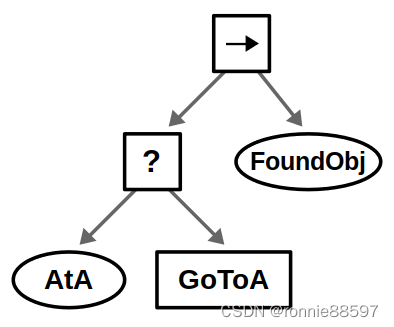
Explicit success conditions use a Fallback node with a condition preceding an action. The guarded action will only execute if the success condition is not met — in this example if the robot is not at location A.
明确的成功条件使用一个Fallback节点,其条件在一个动作之前。只有在不满足成功条件的情况下,受保护的动作才会执行–在这个例子中,如果机器人不在位置A。
Our robot likely operates in an environment with multiple locations, and the idea is to look in all possible locations until we find the object of interest. This can be done by introducing a root-level Fallback node and repeating the above behavior for each location in some specified order.
我们的机器人可能在一个有多个地点的环境中工作,我们的想法是在所有可能的地点寻找,直到找到我们感兴趣的对象。这可以通过引入一个根级的Fallback节点,并以某种特定的顺序对每个位置重复上述行为来实现。
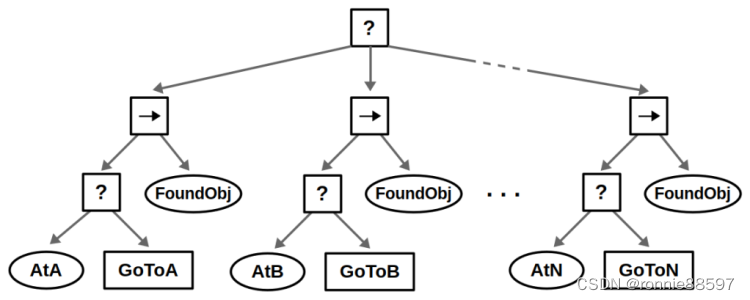
We can also use Fallback nodes to define reactive behaviors; that is, if one behavior does not work, try the next one, and so on.
我们还可以使用Fallback节点来定义反应式行为;也就是说,如果一个行为不起作用,就尝试下一个行为,以此类推。
Finally, suppose that instead of looking for a single object, we want to consider several objects — let’s say apples and oranges. This use case of composing conditions can be done with Parallel nodes as shown below.
最后,假设我们不是在寻找一个单一的对象,而是想考虑几个对象–比方说苹果和橙子。这种合成条件的用例可以用平行节点来完成,如下图所示。
-
If we accept either an apple or an orange (“OR” condition), then we succeed if one node returns Success.
如果我们接受一个苹果或一个桔子("OR "条件),那么如果一个节点返回成功,我们就成功了。
-
If we require both an apple and an orange (“AND” condition), then we succeed if both nodes return Success.
如果我们同时要求一个苹果和一个桔子("AND "条件),那么如果两个节点都返回成功,我们就成功了。
-
If we care about the order of objects, e.g., you must find an apple before finding an orange, then this could be done with a Sequence node instead.
如果我们关心对象的顺序,例如,你必须先找到一个苹果再找到一个橙子,那么这可以用一个序列节点来代替。
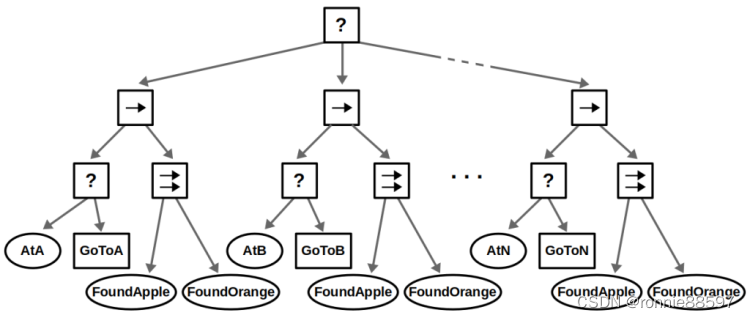
Parallel nodes allows multiple actions and/or conditions to be considered within a single tick.
平行节点允许在一个tick内考虑多个行动和/或条件。
Of course, you can also compose actions in parallel — for example, turning in place until a person is detected for 5 consecutive ticks. While my example is hopefully simple enough to get the basics across, I highly recommend looking at the literature for more complex examples that really show off the power of BTs.
当然,你也可以并行地组成行动–例如,在原地转弯,直到连续5个tick检测到一个人。 虽然我的例子希望简单到足以让人了解基本情况,但我强烈建议查看文献,了解更复杂的例子,真正展示BT的力量。
四、重新审视机器人的例子: 装饰者和黑板
I don’t know about you, but looking at the BT above leaves me somewhat uneasy. It’s just the same behavior copied and pasted multiple times underneath a Fallback node. What if you had 20 different locations, and the behavior at each location involved more than just two simplified execution nodes? Things could quickly get messy.
我不知道你怎么想的,但看了上面的BT,我有些不安。这只是在一个Fallback节点下面复制和粘贴了多次相同的行为。如果你有20个不同的地点,而且每个地点的行为都不止涉及两个简化的执行节点呢?事情很快就会变得混乱。
In most software libraries geared for BTs you can define these execution nodes as parametric behaviors that share resources (for example, the same ROS action client for navigation, or object detector for vision). Similarly, you can write code to build complex trees automatically and compose them from a ready-made library of subtrees. So the issue isn’t so much efficiency, but readability.
在大多数面向BT的软件库中,你可以将这些执行节点定义为共享资源的参数化行为(例如,用于导航的相同ROS动作客户端,或用于视觉的物体检测器)。同样地,你可以编写代码来自动构建复杂的树,并从现成的子树库中组成它们。所以问题不在于效率,而在于可读性。
There is an alternative implementation for this BT, which can extend to many other applications. Here’s the basic idea:
这个BT有一个替代性的实现,可以扩展到许多其他的应用。下面是基本的想法:
-
Introduce decorators: Instead of duplicating the same subtree for each location, have a single subtree and decorate it with a policy that repeats the behavior until successful.
引入装饰器: 与其为每个位置重复相同的子树,不如有一个单一的子树,并用一个策略来装饰它,重复该行为直到成功。
-
Update the target location at each iteration: Suppose you now have a “queue” of target locations to visit, so at each iteration of the subtree you pop an element from that queue. If the queue eventually ends up empty, then our BT fails.
在每次迭代中更新目标位置: 假设你现在有一个要访问的目标位置的 “队列”,那么在子树的每次迭代中,你都会从该队列中弹出一个元素。如果这个队列最终是空的,那么我们的BT就会失败。
In most BTs, we often need some notion of shared data like the location queue we’re discussing. This is where the concept of a blackboard comes in: you’ll find blackboard constructs in most BT libraries out there, and all they really are is a common storage area where individual behaviors can read or write data.
在大多数BT中,我们经常需要一些共享数据的概念,比如我们正在讨论的位置队列。这就是黑板概念的由来:你会在大多数BT库中发现黑板结构,它们实际上就是一个共同的存储区域,各个行为可以在这里读取或写入数据。
Our example BT could now be refactored as follows. We introduce a “GetLoc” action that pops a location from our queue of known locations and writes it to the blackboard as some parameter target_location. If the queue is empty, this returns Failure; otherwise it returns Success. Then, downstream nodes that deal with navigation can use this target_location parameter, which changes every time the subtree repeats.
我们的BT例子现在可以被重构如下。我们引入一个 "GetLoc "动作,从已知位置的队列中弹出一个位置,并将其作为参数target_location写到黑板上。如果队列是空的,这将返回失败;否则,它将返回成功。然后,处理导航的下游节点可以使用这个target_location参数,这个参数在子树每次重复时都会改变。

增加一个黑板和一个 "重复 "装饰器可以大大简化我们的树,即使底层行为是一样的。
You can use blackboards for many other tasks. Here’s another extension of our example: Suppose that after finding an object, the robot should speak with the object it detected, if any. So, the “FoundApple” and “FoundOrange” conditions could write to a located_objects parameter in the blackboard and a subsequent “Speak” action would read it accordingly. A similar solution could be applied, for instance, if the robot needs to pick up the detected object and has different manipulation policies depending on the type of object.
你可以将黑板用于许多其他任务。下面是我们这个例子的另一个扩展: 假设在找到一个物体后,机器人应该与它检测到的物体对话,如果有的话。因此,"FoundApple "和 "FoundOrange "条件可以写入黑板中的located_objects参数,随后的 "Speak "动作会相应地读取它。例如,如果机器人需要拿起检测到的物体,并且根据物体的类型有不同的操作策略,也可以应用类似的解决方案。
Fun fact: This section actually came from a real discussion with Davide Faconti, in which… he essentially schooled me. It brings me great joy to turn my humiliation into an educational experience for you all.
有趣的是:这一部分实际上来自于与Davide Faconti的真实讨论,其中…他基本上是在教育我。把我的羞辱变成对大家的教育,这给我带来了极大的快乐。
五、行为树软件库
Let’s talk about how to program behavior trees! There are quite a few libraries dedicated to BTs, but my two highlights in the robotics space are py_trees and BehaviorTree.CPP.
让我们来谈谈如何对行为树进行编程! 有不少专门用于BT的库,但我在机器人领域的两个亮点是py_trees和BehaviorTree.CPP。
py_trees is a Python library created by Daniel Stonier.
py_trees是一个由Daniel Stonier创建的Python库。
-
Because it uses an interpreted language like Python, the interface is very flexible and you can basically do what you want… which has its pros and cons. I personally think this is a good choice if you plan on automatically modifying behavior trees at run time.
因为它使用了像Python这样的解释语言,所以界面非常灵活,你基本上可以做你想做的事情…这有其优点和缺点。我个人认为,如果你打算在运行时自动修改行为树,这是一个不错的选择。
-
It is being actively developed and with every release you will find new features. However, many of the new developments — not just additional decorators and policy options, but the visualization and logging tools — are already full-steam-ahead with ROS 2. So if you’re still using ROS 1 you will find yourself missing a lot of new things. Check out the PyTrees-ROS Ecosystem page for more details.
它正在被积极开发,每一个版本你都会发现新的功能。然而,许多新的发展–不仅仅是额外的装饰器和策略选项,还有可视化和日志工具–已经在ROS 2中全力推进了。请查看PyTrees-ROS生态系统页面,了解更多细节。
-
Some of the terminology and design paradigms are a little bit different from the Behavior Trees in Robotics book. For example, instead of Fallback nodes this library uses Selector nodes, and these behave slightly differently.
一些术语和设计范式与《机器人学中的行为树》一书有一些不同。例如,本库使用选择器节点,而不是Fallback节点,这些节点的行为方式略有不同。
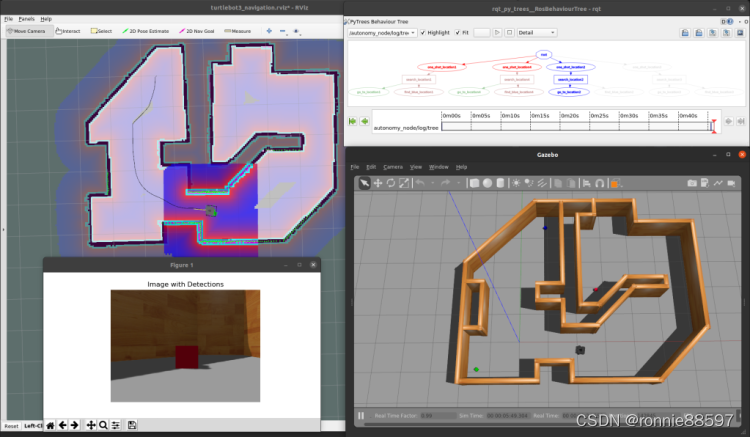
Our navigation example using the py_trees library and rqt_py_trees for visualization.
我们的导航例子使用py_trees库和rqt_py_trees进行可视化。
BehaviorTree.CPP is a C++ library developed by Davide Faconti and Michele Colledanchise (yes, one of the book authors). It should therefore be no surprise that this library follows the book notation much more faithfully.
BehaviorTree.CPP是由Davide Faconti和Michele Colledanchise(是的,本书作者之一)开发的一个C++库。因此,这个库更忠实于书中的符号,这一点应该不足为奇。
-
This library is quickly gaining traction as the behavior tree library of the ROS developers’ ecosystem, because C++ is similarly the language of production quality development for robotics. In fact, the official ROS 2 navigation stack uses this library in its BT Navigator feature.
这个库作为ROS开发者生态系统的行为树库,正在迅速获得吸引力,因为C++同样是机器人技术的生产质量开发语言。事实上,官方的ROS 2导航栈在其BT导航功能中使用了这个库。
-
It heavily relies on an XML based workflow, meaning that the recommended way to author a BT is through XML files. In your code, you register node types with user-defined classes (which can inherit from a rich library of existing classes), and your BT is automatically synthesized!
它在很大程度上依赖于基于XML的工作流程,也就是说,推荐的编写BT的方式是通过XML文件。在你的代码中,你用用户定义的类(可以从丰富的现有类库中继承)注册节点类型,你的BT就自动合成了
-
It is paired with a great tool named Groot which is not only a visualizer, but a graphical interface for editing behavior trees. The XML design principle basically means that you can draw a BT and export it as an XML file that plugs into your code.
它与一个名为Groot的伟大工具相配,该工具不仅是一个可视化工具,而且是一个用于编辑行为树的图形界面。XML设计原则基本上意味着你可以绘制一个BT,并将其导出为XML文件,插入你的代码中。
-
This all works wonderfully if you know the structure of your BT beforehand, but leaves a little to be desired if you plan to modify your trees at runtime. Granted, you can also achieve this using the programmatic approach rather than XML, but this workflow is not documented/recommended, and doesn’t yet play well with the visualization tools.
如果你事先知道你的BT的结构,这一切都很好用,但如果你打算在运行时修改你的树,就有点不尽人意了。当然,你也可以使用编程方法而不是XML来实现这一点,但这种工作流程没有记录/推荐,而且还不能与可视化工具很好地配合。
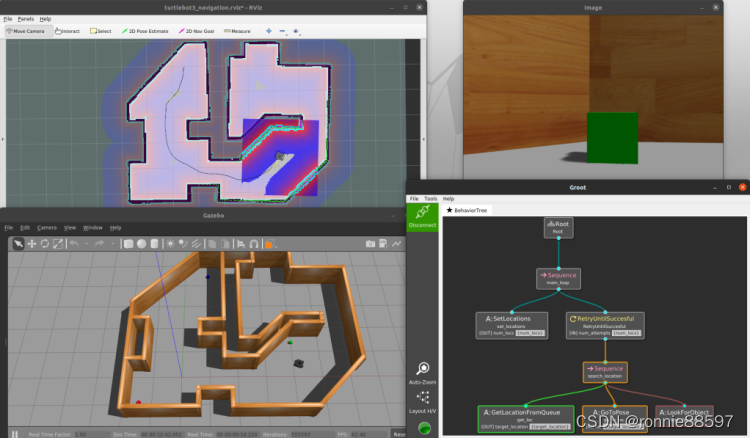
Our navigation example using the BehaviorTree.CPP library and Groot for visualization.
我们的导航例子使用BehaviorTree.CPP库和Groot进行可视化。
So how should you choose between these two libraries? They’re both mature, contain a rich set of tools, and integrate well with the ROS ecosystem. It ultimately boils down to whether you want to use C++ or Python for your development. In my example GitHub repo I tried them both out, so you can decide for yourself!
那么,你应该如何在这两个库中选择呢?它们都很成熟,包含丰富的工具集,并能很好地与ROS的生态系统整合。最终归结为你是想使用C++还是Python进行开发。在我的例子GitHub repo中,我把它们都试了一遍,所以你可以自己决定!
6、行为树VS有限状态机
In my time at MathWorks, I was immersed in designing state machines for robotic behavior using Stateflow — in fact, I even did a YouTube livestream on this topic. However, robotics folks often asked me if there were similar tools for modeling behavior trees, which I had never heard of at the time. Fast forward to my first day at CSAIL, my colleague at the time (Daehyung Park) showed me one of his repositories and I finally saw my first behavior tree. It wasn’t long until I was working with them in my project as a layer between planning and execution, which I describe in my 2020 recap blog post.
在MathWorks工作期间,我沉浸在使用Stateflow为机器人行为设计状态机的过程中–事实上,我甚至在YouTube上做过关于这个主题的直播。然而,机器人行业的人经常问我是否有类似的工具来为行为树建模,当时我从未听说过。快到我在CSAIL的第一天,我当时的同事(Daehyung Park)给我看了他的一个资料库,我终于看到了我的第一个行为树。没过多久,我就在我的项目中使用它们作为计划和执行之间的一层,我在2020年的总结博文中描述了这一点。
As someone who has given a lot of thought to “how is a BT different from a FSM?”, I wanted to reaffirm that they both have their strengths and weaknesses, and the best thing you can do is learn when a problem is better suited for one or the other (or both).
作为一个对 "BT和FSM有什么不同 "进行了大量思考的人,我想重申,它们都有各自的优势和劣势,你能做的最好的事情就是学习什么时候一个问题更适合于一个或另一个(或两者)。
The Behavior Trees in Robotics and AI book expands on these thoughts in way more rigor, but here is my attempt to summarize the key ideas:
《机器人和人工智能中的行为树》一书以更严谨的方式阐述了这些想法,但这里是我试图总结的关键想法:
-
In theory, it is possible to express anything as a BT, FSM, one of the other abstractions, or as plain code. However, each model has its own advantages and disadvantages in their intent to aid design at larger scale.
从理论上讲,任何东西都可以用BT、FSM、其他抽象概念之一,或者用普通代码来表达。然而,每个模型都有自己的优势和劣势,它们的目的是帮助大规模的设计。
-
Specific to BTs vs. FSMs, there is a tradeoff between modularity and reactivity. Generally, BTs are easier to compose and modify while FSMs have their strength in designing reactive behaviors.
具体到BT与FSM,在模块化和反应性之间有一个权衡。一般来说,BT更容易组成和修改,而FSM在设计反应性行为方面有其优势。
Let’s use another robotics example to go deeper into these comparisons. Suppose we have a picking task where a robot must move to an object, grab it by closing its gripper, and then move back to its home position. A side-by-side BT and FSM comparison can be found below. For a simple design like this, both implementations are relatively clean and easy to follow.
让我们用另一个机器人的例子来深入了解这些比较。假设我们有一个拣选任务,机器人必须移动到一个物体上,通过关闭它的抓手抓取它,然后再移动到它的原点。下面是BT和FSM的并列对比。对于这样一个简单的设计,这两种实现方式都比较简洁,容易操作。
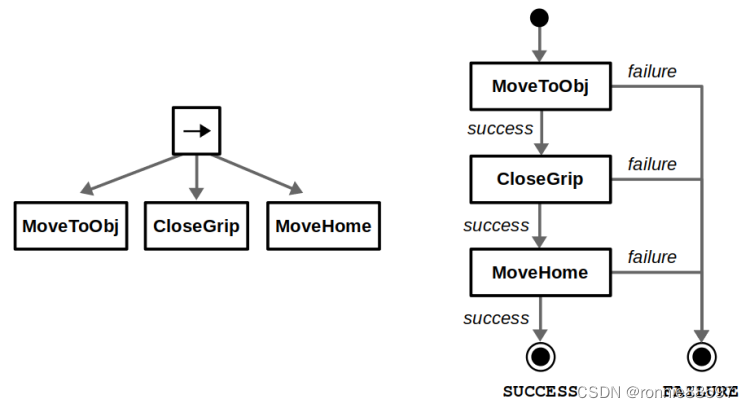
Behavior Tree (left) and Finite-State Machine (right) for our robot picking example.
行为树(左)和有限状态机(右)为我们的机器人采摘例子。
Now, what happens if we want to modify this behavior? Say we first want to check whether the pre-grasp position is valid, and correct if necessary before closing the gripper. With a BT, we can directly insert a subtree along our desired sequence of actions, whereas with a FSM we must rewire multiple transitions. This is what we mean when we claim BTs are great for modularity.
现在,如果我们想修改这个行为会怎样?假设我们首先要检查预抓取位置是否有效,如果有必要,在关闭抓取器之前进行修正。使用BT,我们可以直接沿着我们所需的动作序列插入一个子树,而使用FSM,我们必须重新连接多个转换。这就是我们所说的BT很适合模块化的意思。
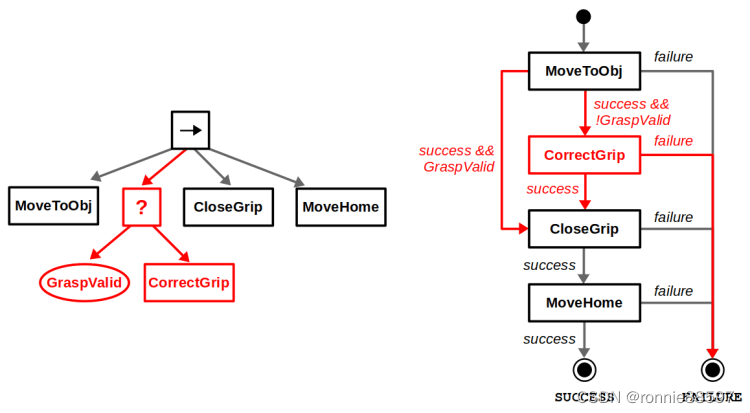
Modifications to our BT (left) and FSM (right) if we want to add a pre-grasp correction behavior.
如果我们想增加一个预抓取纠正行为,对我们的BT(左)和FSM(右)进行修改。
On the other hand, there is the issue of reactivity. Suppose our robot is running on a finite power source, so if the battery is low it must return to the charging station before returning to its task. You can implement something like this with BTs, but a fully reactive behavior (that is, the battery state causes the robot to go charge no matter where it is) is easier to implement with a FSM… even if it looks a bit messy.
另一方面,还有一个反应性的问题。假设我们的机器人是在有限的电源上运行,所以如果电池电量不足,它必须在返回任务之前返回充电站。你可以用BT来实现这样的东西,但是一个完全反应性的行为(也就是说,无论机器人在哪里,电池状态都会导致它去充电)更容易用FSM来实现…即使它看起来有点乱。
On the note of “messy”, behavior tree zealots tend to make the argument of “spaghetti state machines” as reasons why you should never use FSMs. I believe that is not a fair comparison. The notion of a hierarchical finite-state machine (HFSM) has been around for a long time and helps avoid this issue if you follow good design practices, as you can see below. However, it is true that managing transitions in a HFSM is still more difficult than adding or removing subtrees in a BT.
关于 “混乱”,行为树的狂热者倾向于提出 "意大利语状态机 "的论点,作为你不应该使用FSM的理由。我认为这并不是一个公平的比较。分层有限状态机(HFSM)的概念已经存在了很长时间,如果你遵循良好的设计实践,它有助于避免这个问题,你可以在下面看到。然而,在HFSM中管理过渡确实比在BT中添加或删除子树更困难。
There have been specific constructs defined to make BTs more reactive for exactly these applications. For example, there is the notion of a “Reactive Sequence” that can still tick previous children in a sequence even after they have returned Success. In our example, this would allow us to terminate a subtree with Failure if the battery levels are low at any point during that action sequence, which may be what we want.
有一些特定的结构被定义为使BT在这些应用中更具有反应性。例如,有一个 "反应式序列 "的概念,它可以在序列中勾选先前的子树,即使它们已经返回成功。在我们的例子中,这将允许我们在行动序列中的任何时候,如果电池电量不足,就以失败来终止子树,这可能是我们想要的。
-
Adding a battery check and charging action to a BT is easy, but note that this check is not reactive — it only occurs at the start of the sequence. Implementing more reactivity would complicate the design of the BT, but is doable with constructs like Reactive Sequences.
在BT中添加电池检查和充电动作是很容易的,但要注意这个检查不是反应性的–它只发生在序列的开始。实现更多的反应性会使BT的设计复杂化,但用反应性序列这样的结构是可以做到的。
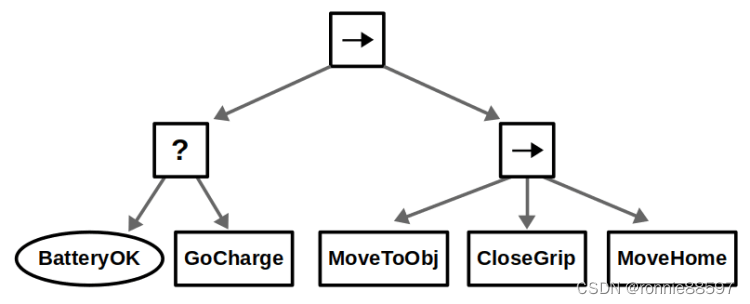
-
FSMs can allow this reactivity by allowing the definition of transitions between any two states.
FSM可以通过允许定义任何两个状态之间的转换来允许这种反应性。
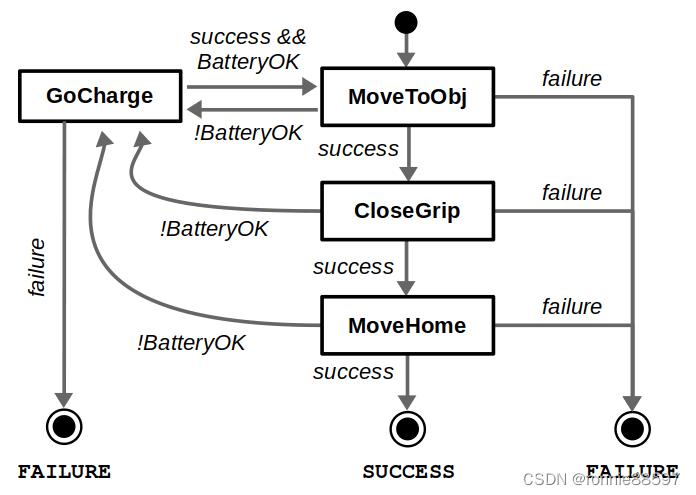
-
Hierarchical FSMs can clean up the diagram. In this case, we define a superstate named “Nominal”, thus defining two clear operating modes between normal operation and charging.
层次化的FSM可以清理图示。在这种情况下,我们定义了一个名为 "Nominal "的超状态,从而定义了正常运行和充电之间的两种明确的运行模式。

Because of this modularity / reactivity tradeoff, I like to think that FSMs are good at managing higher-level operating modes (such as normal operation vs. charging), and BTs are good at building complex sequences of behaviors that are excellent at handling recoveries from failure. So, if this design were up to me, it might be a hybrid that looks something like this:
由于这种模块化/反应性的权衡,我认为FSM擅长管理更高层次的操作模式(如正常操作与充电),而BT擅长建立复杂的行为序列,在处理故障恢复方面非常出色。因此,如果这个设计是由我决定的,它可能是一个混合体,看起来像这样:
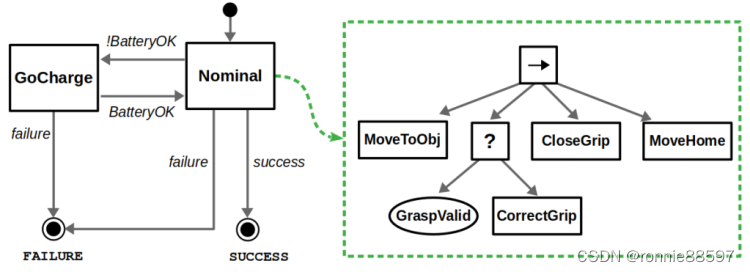
Best of both worlds: High-level mode switches are handled by a FSM and mode-specific behaviors are managed with BTs.
两者兼而有之:高层模式切换由FSM处理,特定模式的行为由BT管理。
结论
Thank for reading through this introductory post, and I look forward to your comments, questions, and suggestions. If you want to try the code examples, check out my example GitHub repository.
谢谢你读完这篇介绍性文章,我期待着你的评论、问题和建议。如果你想尝试代码示例,请查看我的示例GitHub存储库。
To learn more about behavior trees, here are some good resources that I’ve relied on over the past year and a bit.
要了解更多关于行为树的信息,这里有一些我在过去一年多时间里所依赖的好资源。
- Behavior Trees in Robotics and AI: An Introduction — textbook by Michele Colledanchise and Petter Ögren. I cannot recommend this one enough!
- py_trees and BehaviorTree.CPP software libraries.
- Behavior Trees for AI: How They Work — blog post by Chris Simpson.
- Slides comparing Hierarchical FSMs and BTs, by Kyong-Sok Chang and David Zhu.





















 990
990











 被折叠的 条评论
为什么被折叠?
被折叠的 条评论
为什么被折叠?








